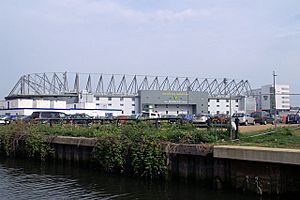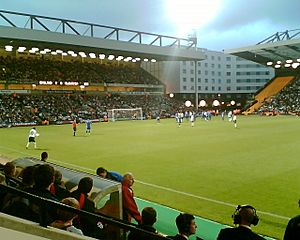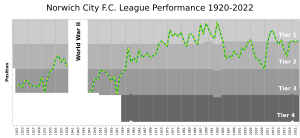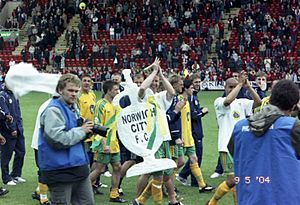History of Norwich City F.C. facts for kids

The history of Norwich City F.C. goes all the way back to 1902. After playing as an amateur team for a short time, Norwich City F.C. became a semi-professional team. They played in the Southern Football League for 15 years. Then, in 1920, they joined the English Football League.
For almost 50 years, Norwich City played in Division Three (South). This was one of the lowest levels of the football league. A famous moment during this time was their amazing journey to the FA Cup semi-finals in 1959. Soon after, the club won its first big trophy, the League Cup in 1962. Norwich finally reached the top league in 1972. This was their first time being promoted to the highest level of English football.
Since then, Norwich City has been known as a "yo-yo club". This means they often move between the top league and the second-highest league. By the end of the 2017–18 season, they had spent 25 seasons in the top league and 19 in the second. Most of the club's biggest achievements happened during this period. They won their second major trophy, the League Cup in 1985. They also reached two more FA Cup semi-finals. They finished fifth, fourth, and third in the top division. A very famous moment was when they beat Bayern Munich in the UEFA Cup.
Throughout its history, Norwich City has faced challenges that threatened its existence. These included being kicked out of amateur football and needing to be re-elected to The Football League. They also faced serious money problems. Geoffrey Watling was a very important person who helped save the club from bankruptcy. He became the club chairman, and a stand at their stadium, Carrow Road, is named after him. He helped save the club in the 1950s and 1990s. His father had also played a similar role in 1919.
Contents
How it All Began: 1902–1930
Norwich City F.C. was started on June 17, 1902. A group of friends, led by two former Norwich CEYMS players, met at the Criterion Cafe in Norwich. Their first official match was against Harwich & Parkeston on September 6, 1902. They also joined the Norfolk & Suffolk League for the 1902–03 season.
The club was first called the Citizens. They played in light blue and white shirts. By April 1905, people started calling them "The Canaries" because raising canaries was a popular hobby. By February 1907, this moniker (nickname) was used by newspapers across the country. The next season, inspired by the nickname, City played in yellow shirts with green collars and cuffs. A local newspaper said, "The Cits are dead but the Canaries are very much alive."
Norwich played as an amateur club for just over two seasons. In 1904, the Football Association (FA) found that the club was actually professional. This meant they could not play in amateur football anymore. The club had paid players and spent money on training, which was not allowed for amateur teams. Because of this, the club officials had to leave their jobs.
The club quickly decided to become a professional team. Wilfrid Lawson Burgess became the first chairman of the professional club. On May 30, 1905, Norwich was chosen to play in the Southern League.
The team's matches became more popular, and more fans came to watch. This meant they needed a bigger stadium. Norwich had to leave their old ground, Newmarket Road. They moved to a converted chalk pit called "The Nest". The stands from Newmarket Road were moved and rebuilt at The Nest. The new ground was ready for the 1908–09 season.
On December 10, 1917, during the First World War, football games were stopped. The club was in a lot of debt and had to close down temporarily. The club was officially restarted on February 15, 1919. Mr. C Watling, the father of future chairman Geoffrey Watling, was very important in bringing the club back.
In May 1920, the Football League created a Third Division. Norwich was accepted into this division for the next season. Their first league game was against Plymouth on August 28, 1920. It ended in a 1–1 draw. For the next ten years, the club had average results. They finished no higher than eighth and no lower than 18th. During this time, players started wearing a canary emblem on their shirts. A simple canary badge was first used in 1922, and a similar design is still used today.
Climbing to the Top: 1930–1972
The 1930s started with a close call for Norwich. They finished last in the league in 1931. However, they were allowed to stay in the league after a vote. The rest of the decade was much better. Norwich had a club-record 10–2 victory over Coventry City. They also won promotion to the Second Division in the 1933–34 season. This was under the manager Tom Parker.

With more and more fans coming to games, and the Football Association worried about The Nest, the club decided to move. They chose to build a new stadium called Carrow Road. The original stadium had standing areas on three sides. Only one stand, along Carrow Road, had wooden seats and a roof. It took only 82 days to build the stadium! The first match at the new ground was on August 31, 1935, against West Ham United. Norwich won 4–3, and a new record crowd of 29,779 people came to watch. A special moment in the fourth season at Carrow Road was the visit of King George VI on October 29, 1938. This was the first time a king had attended a second-tier football match. The club was relegated back to the Third Division at the end of that season. It was a very close call, as they were demoted by a tiny difference in goal average.
The league was stopped the next season because of the Second World War. Professional football did not start again until the 1946–47 season. City finished 21st in this season and the next. Their poor results meant the club had to ask to be re-elected to the league. Even with the team not playing well, many fans still came to watch. In 1948, Carrow Road had its record attendance of 37,863 spectators. They watched City play Notts County.
The club almost got promoted under manager Norman Low in the early 1950s. But when Tom Parker returned as manager, Norwich finished last in the football league in the 1956–57 season. Off the field, the club faced serious money problems. They owed more than £20,000. The club was saved by a new board, led by Geoffrey Watling. An appeal fund, led by the Lord Mayor of Norwich, Arthur South, raised over £20,000. Both men were later honored by having stands named after them at Carrow Road.
Archie Macaulay became manager when the club was reformed. He led Norwich to one of their greatest achievements: reaching the semi-final of the 1958–59 FA Cup. As a Third Division team, Norwich beat two First Division opponents. This included a famous 3–0 win against Manchester United's "Busby Babes". City lost the semi-final after a replay against another First Division team, Luton Town. The team from 1958–59 is still remembered today. Players like Terry Bly, who scored seven goals, and Ken Nethercott, who played with a dislocated shoulder, are in the club Hall of Fame. This "59 Cup Run" is still seen as one of the best times in Norwich City's history. Norwich was only the third Third Division team ever to reach the FA Cup semi-final.
In the 1959–60 season, Norwich was promoted to the Second Division. They finished second behind Southampton. They then finished fourth in the 1960–61 season. From 1960, Norwich spent the next 12 seasons in the second tier. They finished fourth in 1961 and sixth in 1965.
In 1962, Ron Ashman guided Norwich to their first trophy. They beat Rochdale 4–0 on total score over two games to win the League Cup. Norwich finally won promotion from Division Two when they finished as champions in the 1971–72 season. This was under manager Ron Saunders. Norwich City had reached the highest level of English football for the very first time.
The "Yo-Yo" Years: 1972–1992
Norwich played at Wembley Stadium for the first time in 1973. They lost the League Cup final 1–0 to Tottenham Hotspur. They were relegated to the Second Division in 1974. This led to manager Saunders leaving, and John Bond taking over. His first season was very successful. They were promoted back to the First Division and visited Wembley again. This time, in the League Cup final, they lost 1–0 to Aston Villa.
They stayed in the top league for another six seasons. The club finished tenth in the 1975–76 season. This was their highest finish ever at the time. During Bond's time, a new stand was built at Carrow Road. Bond resigned during the 1980–81 season, and the club was relegated. But they bounced back the next season by finishing third.
The 1984–85 season had good and bad moments. A fire destroyed the old Main Stand on October 25, 1984. But on the field, under Ken Brown's management, they reached the final of the Milk Cup at Wembley Stadium. They beat local rivals Ipswich Town in the semi-final. In the final, they beat Sunderland 1–0. However, in the league, both Norwich and Sunderland were relegated to the second tier. Norwich had qualified for the UEFA Cup, but they could not play in Europe. This was because English clubs were banned after the Heysel Stadium disaster.
City immediately returned to the top league by winning the Second Division championship in the 1985–86 season. High league finishes in the First Division in 1988–89 would have been enough for UEFA Cup qualification. But the ban on English clubs was still in place. They also had good runs in cup competitions. They reached the FA Cup semi-finals in 1989 and again in 1992.
Europe, Highs and Lows: 1992–1999
In 1992–93, the first season of the English Premier League, Norwich City surprised everyone. Many thought they would be relegated. But they led the league for much of the season. They were eight points clear of other teams before Christmas. They ended up finishing third, behind champions Manchester United and Aston Villa. They showed they were a strong team from the very first day. They had an impressive 4–2 away win over Arsenal, who were expected to challenge for the title. This was a big surprise to many experts.
The next season, Norwich played in the UEFA Cup for the first time. They beat Vitesse Arnhem from the Netherlands 3–0 in the first round. In the second round, they played Bayern Munich from Germany. Norwich won the match 3–2 on total score. Their 2–1 victory in Munich made history. They became the only English team to beat Bayern Munich in the Olympic Stadium. The Independent newspaper called the win in Munich "the pinnacle of Norwich City's history". Four Four Two magazine said, "The news that Norwich had gone 2–0 up in the Olympic Stadium seemed frankly surreal." Norwich's cup journey ended when Italy's Internazionale beat them 2–0 over two games.
Mike Walker's success at Norwich attracted attention. In January 1994, he left the club to manage Everton. Walker's replacement was first team coach John Deehan. He was helped by Gary Megson, who was still a player. Deehan led the club to 12th place in the 1993–94 season in the Premier League.

In 1994, the club sold 21-year-old striker Chris Sutton to Blackburn Rovers. This was for a British record fee of £5 million at the time. By Christmas 1994, Norwich City was seventh in the Premiership. They were hoping to return to the UEFA Cup. But after a serious injury to goalkeeper Bryan Gunn, the club's performance dropped sharply. They won only one of their last 20 Premiership games. Norwich fell to 20th place and were relegated to the second tier. Deehan resigned just before relegation was confirmed. Megson took over as temporary manager until the end of the season.
Martin O'Neill was appointed manager in mid-1995. He had led Wycombe Wanderers to two promotions. But he only lasted six months at Norwich. He resigned after a disagreement with chairman Robert Chase. Chase refused to let O'Neill spend much money on new players. Soon after O'Neill left, Chase also stepped down. Supporters had complained that he kept selling the club's best players and was to blame for the relegation. Between 1992 and January 1995, Norwich had sold several key attacking players. These included Robert Fleck, Ruel Fox, Chris Sutton, Efan Ekoku, and Mark Robins.
Nearly 40 years after helping save the club from bankruptcy, Geoffrey Watling bought Chase's shares. Gary Megson was appointed Norwich manager temporarily for the second time in eight months. Megson stayed in charge until the end of the season before leaving. Just four seasons after finishing third in the Premiership and beating Bayern Munich, Norwich finished 16th in Division One.
English television cook Delia Smith and her husband Michael Wynn-Jones took over most of Norwich City's shares from Watling in 1996. Mike Walker was re-appointed as manager. He could not repeat his earlier success. He was sacked two seasons later with Norwich in the middle of the First Division table. His replacement, Bruce Rioch, lasted two seasons and left in mid-2000. Promotion had still not been achieved.
New Millennium and Centenary: 2000–Today

Rioch's replacement, Bryan Hamilton, lasted six months. He resigned with the club 20th in the First Division. They were in danger of being relegated to the third tier for the first time since the 1960s. The new manager was Nigel Worthington, who had been Hamilton's assistant. Worthington's time as Norwich manager had its ups and downs. In his first partial season, he successfully kept the team from being relegated. The next season, Norwich did better than expected. They reached the 2002 play-off final, but lost to Birmingham City on penalties.
Norwich City celebrated its 100th birthday in 2002. As part of the celebrations, they created a Hall of Fame. This was to honor players, coaches, managers, and others who had made a big contribution to the club. Initially, 100 important people from the club's history were honored. 25 were chosen by the club, and 75 were chosen by fans. Another 10 members were added in 2006, also chosen by supporters.
After a season of staying in the league, Worthington led the club to the First Division title in 2003–04. They won by eight points. Norwich returned to the top league for the first time in nine years. For much of the 2004–05 season, the club struggled in the Premiership. But the team made an amazing comeback in the final weeks. Norwich, who hadn't won in months, earned 13 points out of a possible 18. On the last day of the season, the club needed a win to stay in the top league. But a 6–0 away defeat to Fulham meant they were relegated.
The club was expected to quickly return to the Premiership in the 2005–06 season. But a very bad first four months saw City drop to 18th in The Championship. Fans started to get upset with Nigel Worthington. Dean Ashton was sold for a club-record £7 million. This was about double what they had paid for him a year earlier. Half of Ashton's fee was used to buy Welsh striker Robert Earnshaw. He helped the team improve to a ninth-place finish. Worthington made only one permanent signing in the off-season. When a poor run of results followed, leaving the club in 17th place, he was fired. First team coach Martin Hunter was temporary manager for two weeks. Then, former City player Peter Grant left West Ham United to become the new manager.
Grant managed to lift the team to finish 16th in the league. In the 2007 off-season, Grant brought in nine new players. Ten players, including Earnshaw, left. Darren Huckerby criticized the club for selling their best players. The 2007–08 season started with only two Norwich wins by early October. Grant left the club by "mutual consent" (meaning both sides agreed). On October 30, former Newcastle United boss Glenn Roeder was confirmed as the new manager. Roeder let several players go. He mostly replaced them with young players on loan. Results improved greatly. The club moved from five points adrift at the bottom of the table to a comfortable mid-table position. After a poor first half of the 2008–09 season, Roeder was fired in January 2009.
The appointment of the club's "legendary former goalkeeper," Bryan Gunn, as manager did not stop them from being relegated. They fell to the third tier of English league football (League One). This was a level the club had not played at since 1960. Norwich started their League One season at home against Colchester United. Many expected them to quickly return to the Championship. But they suffered a shocking 1–7 defeat. This was their worst home defeat in 107 years. Gunn was sacked six days later. The club quickly appointed the man who had led Colchester to that big win, Colchester manager Paul Lambert.
Lambert led a huge turnaround. He guided Norwich to promotion back to The Championship as League One champions. This season included a 16-game unbeaten run. The next season, Norwich won both Old Farm derby matches against Ipswich Town. They finished runners-up and returned to the Premier League after a six-year absence.
The club finished 12th in their first season back in the Premier League. But Lambert resigned within a month of the season ending. He was replaced by Chris Hughton for the 2012–13 season. Hughton's time started poorly. But a bad run was followed by a club record unbeaten run in the Premier League. Norwich secured their third year in a row in the Premier League. A 1–0 home defeat to Luton Town that season meant Norwich became the first English top-flight team to lose an FA Cup tie to a non-league side in 24 years.
At the end of the 2013–14 season, Hughton's second as manager, he was replaced by former Norwich player Neil Adams. This happened shortly before Norwich were relegated back to the Championship. After an average first half of the 2014–15 season, Adams resigned. Hamilton Academical manager Alex Neil was appointed in January 2015. At 33 years old, he was the second youngest manager in the Football League. His appointment gave Norwich's season new energy. They narrowly missed out on automatic promotion. But victory in the 2015 Championship playoff final secured an immediate return to the top division. During the 2015–16 season, former Shadow Chancellor Ed Balls became chairman. At the end of that season, Norwich was relegated again. They played in the 2016–17 EFL Championship. When it became clear the club would not be promoted, Neil left his job. He was replaced in May 2017 by German coach, Daniel Farke, on a two-year contract. In 2017/18, Farke's first season saw Norwich finish 14th in the 2017–18 EFL Championship table. The 2018–19 season saw Norwich City promoted back to the Premier League. They won the title on the final day with a 2–1 win over Aston Villa at Villa Park. However, Norwich's stay in the Premier League was short. The club was relegated a year later, finishing last with only 21 points.
After the year 2000, the club changed how it was run as a business. When a new business management team was appointed at the start of the 2009–10 season, the club was in debt. A lot of work was done to fix the finances. They planned to pay back all debt within five years. In 2016, the club announced that it was debt-free.
|



